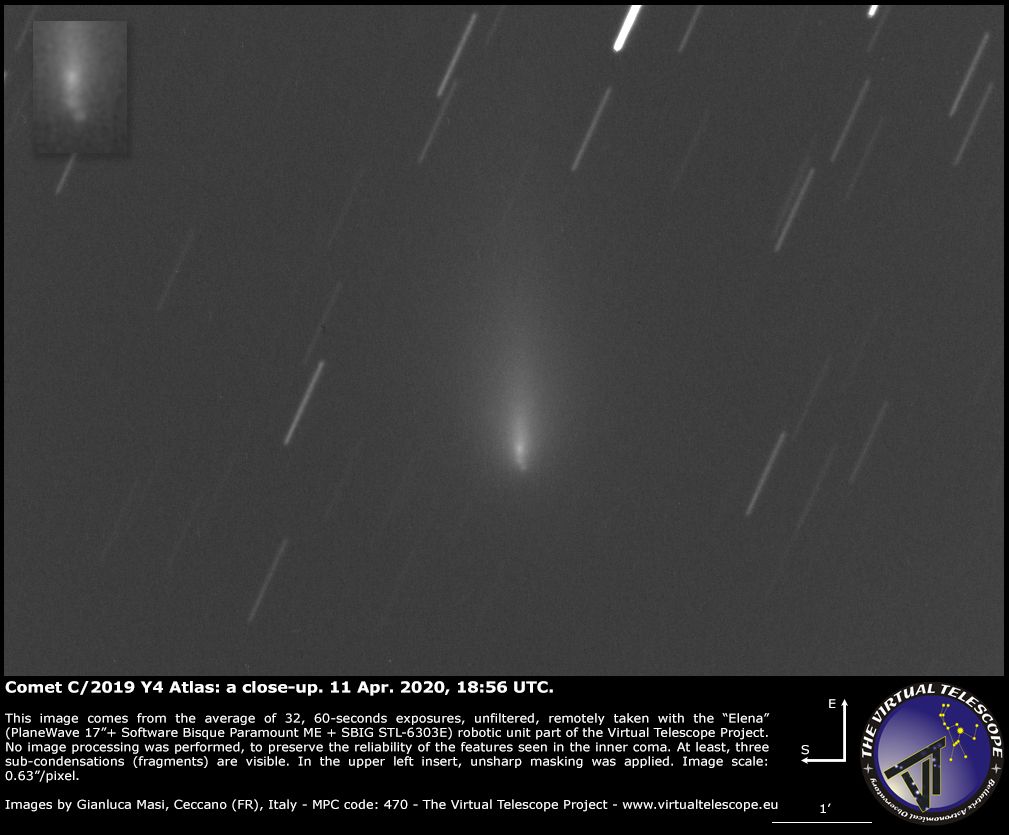
Discovered late last year, C/2019 Y4 ATLAS was supposed to be the brightest comet to decorate the night sky in decades.
But now it appears to have suffered a major collapse.
C/2019 Y4 ATLAS has fragmented into three or four pieces, according to the Virtual Telescope Project 2.0, a group that uses remotely controlled telescopes to observe space, thus corroborating my previous hypothesis made a few days ago.
Images taken on April 11 and 12 show discernible pieces inside the comet’s inner coma, indicating a recent breakup event.
This is a real shame, because C/2019 Y4 ATLAS was set to be the brightest comet in the night sky since Hale-Bopp in 1997.
The comet was supposed to become visible to the naked eye later this month, but this doesn’t seem likely now, given the serious fragmentation event.
C/2019 Y4 ATLAS
The comet was discovered on December 28, 2019 by the Asteroid Terrestrial-impact Last Alert System (ATLAS) in Hawaii.
C/2019 Y4 ATLAS is a near-parabolic comet with a highly eccentric orbit that delivers the object to the inner solar system once every 6,000 years.
A surprise, but not so big
That the comet has fizzled out is not a complete surprise, given the rapid rate at which it was brightening.
As the comet got closer to the Sun, it began to release “huge amounts of frozen volatiles,” explained astrophysicist Karl Battams from the Naval Research Lab in Washington DC, who spoke to Space Weather Archive last month, prior to the fragmentation event.
C/2019 Y4 ATLAS was clearly spewing out lots of gases, which likely contributed to its collapse.
Astronomers began to notice some odd cometary behavior during the first week of April.
In an Astronomer’s Telegram post dated April 6, astronomer Quanzhi Ye from the University of Maryland said he noticed an elongated “pseudo-nucleus” that was “aligned with the axis of the tail.”

Such a shape is “consistent with a sudden decline or cessation of dust production, as would be expected from a major disruption of the nucleus,” he wrote.
This was later confirmed by Masi, who took photos of C/2019 Y4 ATLAS this past weekend.
A photo taken on April 12 shows four discrete “sub-condensations,” or cometary fragments, “with evident changes in the brightness distribution,” wrote Masi. The westernmost fragment appears to be the largest, he said.
RIP Comet Atlas! It’s really too bad that this happened, as we could’ve really used a shining light in the night sky right about now.
Is this another sign of the End Times? More space news on Strange Sounds and Steve Quayle. [Gizmodo]













Hmmm, what a shame. Now I have to delete all the entries in my calendar. Hale-Bopp was a decent show back in 1997. We all went out to watch that one.